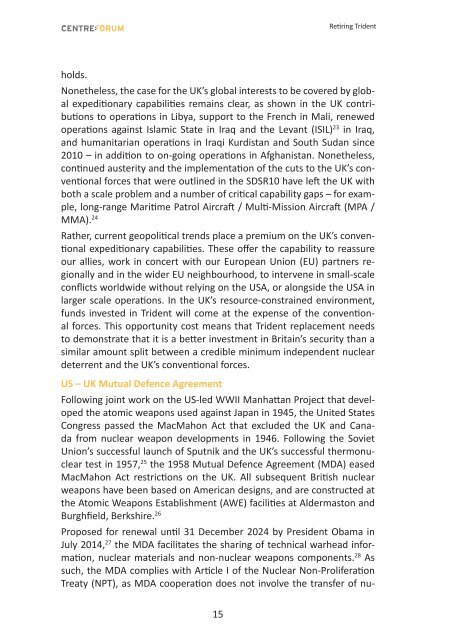Retiring Trident
retiring-trident
retiring-trident
You also want an ePaper? Increase the reach of your titles
YUMPU automatically turns print PDFs into web optimized ePapers that Google loves.
<strong>Retiring</strong> <strong>Trident</strong><br />
holds.<br />
Nonetheless, the case for the UK’s global interests to be covered by global<br />
expeditionary capabilities remains clear, as shown in the UK contributions<br />
to operations in Libya, support to the French in Mali, renewed<br />
operations against Islamic State in Iraq and the Levant (ISIL) 23 in Iraq,<br />
and humanitarian operations in Iraqi Kurdistan and South Sudan since<br />
2010 – in addition to on-going operations in Afghanistan. Nonetheless,<br />
continued austerity and the implementation of the cuts to the UK’s conventional<br />
forces that were outlined in the SDSR10 have left the UK with<br />
both a scale problem and a number of critical capability gaps – for example,<br />
long-range Maritime Patrol Aircraft / Multi-Mission Aircraft (MPA /<br />
MMA). 24<br />
Rather, current geopolitical trends place a premium on the UK’s conventional<br />
expeditionary capabilities. These offer the capability to reassure<br />
our allies, work in concert with our European Union (EU) partners regionally<br />
and in the wider EU neighbourhood, to intervene in small-scale<br />
conflicts worldwide without relying on the USA, or alongside the USA in<br />
larger scale operations. In the UK’s resource-constrained environment,<br />
funds invested in <strong>Trident</strong> will come at the expense of the conventional<br />
forces. This opportunity cost means that <strong>Trident</strong> replacement needs<br />
to demonstrate that it is a better investment in Britain’s security than a<br />
similar amount split between a credible minimum independent nuclear<br />
deterrent and the UK’s conventional forces.<br />
US – UK Mutual Defence Agreement<br />
Following joint work on the US-led WWII Manhattan Project that developed<br />
the atomic weapons used against Japan in 1945, the United States<br />
Congress passed the MacMahon Act that excluded the UK and Canada<br />
from nuclear weapon developments in 1946. Following the Soviet<br />
Union’s successful launch of Sputnik and the UK’s successful thermonuclear<br />
test in 1957, 25 the 1958 Mutual Defence Agreement (MDA) eased<br />
MacMahon Act restrictions on the UK. All subsequent British nuclear<br />
weapons have been based on American designs, and are constructed at<br />
the Atomic Weapons Establishment (AWE) facilities at Aldermaston and<br />
Burghfield, Berkshire. 26<br />
Proposed for renewal until 31 December 2024 by President Obama in<br />
July 2014, 27 the MDA facilitates the sharing of technical warhead information,<br />
nuclear materials and non-nuclear weapons components. 28 As<br />
such, the MDA complies with Article I of the Nuclear Non-Proliferation<br />
Treaty (NPT), as MDA cooperation does not involve the transfer of nu-<br />
15




